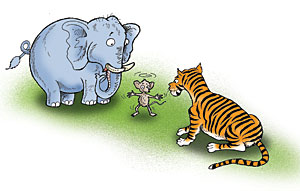 BILASH RAI |
Nepal's founding king called the country a yam between two rocks, and just as it was during the Great Game, recent strains in India-China relations are affecting the state of play in Kathmandu politics.
Complicating things further is the barely concealed schism within the New Delhi political establishment between conservative advisers close to Prime Minister Man Mohan Singh's secretariat and the bureaucracy on everything from the nuclear deal with the US, climate change and dealing with a newly assertive China.
Hawks in the New Delhi military intelligence establishment see Beijing overturning a long-standing accommodation to put the border dispute in the Himalaya in deep freeze while both countries concentrate on economic growth.
Nepal and China suddenly loom large in the Indian media, and often both are mentioned together in jingoistic coverage that is said to be fed by leaks from hawks. After an incident on a border lake in Ladakh mid-September, TV news channels aired alarmist coverage titled 'Enter the Dragon'. Another channel labelled Nepal the 'Number Three Enemy' of India after China and Pakistan.
The main reason for the suspicion is the belief that Nepal's Maoist government is getting too cosy with China.
"Silently but speedily China is spreading its wings in the erstwhile Hindu kingdom, mainly to unleash anti-India propaganda," wrote the Times of India last week. Nepal is getting entangled in Delhi's Sinophobia as the Indian media gives prominent space to reports of China smuggling arms through Nepali Maoists to Naxalites in India. Statements like those made by Maoist leader CP Gajurel don't help: "We fully support and cooperate with the Indian Maoists in their armed revolt."
Several factors have contributed to a new cold war across the Himalaya: the recent geopolitical alignment between India and the US, Beijing's insecurity about Tibetan nationalism, and competition between the two countries over water from Himalayan rivers.
India and China reaffirmed their agreement on spheres of influence at a historic rapprochement between Deng Xiaoping and Rajiv Gandhi in Beijing in December 1988. That deal appears to have unravelled in the past year due to tension between the two countries.
Suspicions of Chinese intent, and the defeat of the Communist Party of India, have resulted in an attempt by hardliners in the New Delhi establishment to re-evaluate the Indian brokered peace accord in Nepal at the expense of Nepal's Maoists.
But despite differences, there is still a convergence of interest between India and China on Nepal: both want stability. Last month's meeting between Man Mohan Singh and Chinese Premier Hu Jintao on the sidelines of an ASEAN summit in Thailand did clear the air a bit, and there are indications that Premier Hu re-emphasised the need for political unity in Nepal during his brief handshake with Pushpa Kamal Dahal in Sandong in October.
"India and China are just pretending to shadow box over Nepal," said one senior foreign policy specialist here. "Their rivalry is elsewhere and essentially both would prefer not to have the headache of a failed state between them."
Indeed, some Indian academics say China-India ties can mirror China-Japan relations where trade and diplomatic ties continue to grow despite territorial disputes and geopolitical rivalry. China is now one of India's top three trading partners and they do cooperate on issues like global trade and climate change.
What has prompted India and China to seek leverage in Nepal, say some Nepal-watchers here, may perhaps have less to do with their geopolitical rivalry than the deadlock in Nepal's peace process and the fluid political situation in Kathmandu. A weak state will tempt both neighbours to push their national agenda: China to seek a government less reluctant to crackdown on Tibetans and India to push leaders more likely to deliver on its need for water and energy.
But ultimately, "both China and India realise that this will only happen when there is a strong and stable government in Kathmandu," explained the foreign policy specialist. And the answers to that conundrum lie neither in India, nor in China.
READ ALSO:
"India shouldn't be suspicious" - FROM ISSUE #474 (30 OCT 2009 - 05 NOV 2009)
Hu cares? - FROM ISSUE #473 (23 OCT 2009 - 29 OCT 2009)
Unstable stability, by Prashant Jha - FROM ISSUE #473 (23 OCT 2009 - 29 OCT 2009)
Nepal goes to India, by CK Lal - FROM ISSUE #463 (07 AUG 2009 - 13 AUG 2009)
Delhi view - FROM ISSUE #372 (02 NOV 2007 - 08 NOV 2007)


